Is Manual Lymphatic Drainage with BMT for lipedema and lymphedema the answer?
I guess it depends on the questions, but so far, we are finding that for the treatment and management of Lipedema and Lymphedema, our clients are certainly excited about the results they’re getting with this treatment. “Life-changing” was the word recently used by one of my clients.
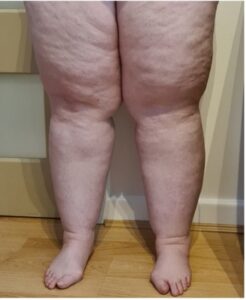
Lipedema and lymphedema are two of many forms of oedema.
Lymphedema is a condition where the accumulation of excessive amounts of protein-rich fluid in the tissue results in swelling of one or more regions of the body. Lymphedema usually affects the limb(s) although it may also involve the trunk, breast, head and neck or genital area. These body regions are generally associated with lymphatic territories (also called lymphosomes). Lymphedema is due to a failure of the lymphatic system and occurs when the demand for lymphatic drainage exceeds the capacity of the lymphatic circulation (1)
Lipedema is a chronic medical condition characterized by a symmetric buildup of adipose tissue (fat) in the legs and arms. A common but under recognised disorder, Lipedema may cause pain, swelling, and easy bruising. It may be accompanied by an unusual texture within the fat that can feel like rice, peas, or walnuts beneath the surface of the skin. The intensity of pain may range from none to severe, and its frequency may be constant, come and go, or only occur when the fat is pushed on. Limited public awareness of lipedema, coupled with few research-backed treatments, can lead to exacerbation of symptoms as well as physical and emotional distress. Common symptoms include fatigue, muscle pain, or easy bruising.(2)
In this case study, we explore the use of non-invasive treatment methods, including manual lymph drainage (MLD), and Bioelectric Meridian Therapy (BMT) in the treatment of lipedema and lymphedema.
My name is Andrea Pluck, and I have been a remedial therapist for over 10 years, with additional qualifications in oncology massage and decongestive lymphatic therapy (amongst others).
Case Presentation for lipedema and lymphedema treatment
A 41-year-old mother and sonographer, presented with chronic lipedema and lymphedema in both legs. She had been unable to walk even short distance (from the house to the letterbox) for several years due to the swelling and pain in her legs. She had been unable to bend her knees for more than 15 degrees. This was having an impact on her quality of life, preventing her from walking to her daughter’s classroom or doing any physical activities with her daughter. She was working half a day a week as this was all she could manage.
Patient’s other significant medical history: multiple chronic conditions including psoriasis, spondylarthritis, asthma, coeliac. Was first diagnosed by a GP with lipedema and lymphedema in 2023.
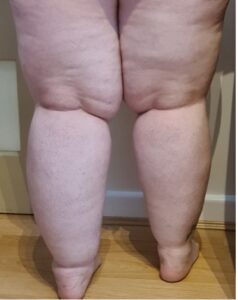
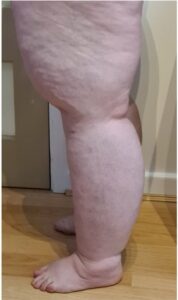
After diagnosis, a ketogenic diet and physiotherapy for Manual Lymphatic Drainage were recommended by the GP but the client found no improvement nor relief in her symptoms despite persisting for 6 months. Wearing compression was intolerable to the client as off the shelf garments were ill-fitting and painful, and she could not afford custom made garments. She was not eligible for compression garments under the Medicare scheme due to her lipedema.
For our sessions, we planned a course of treatment that would involve MLD with BMT, with the primary aim of reducing limb volume and discomfort/pain.
Multi-modal treatment for lipedema and lymphedema
Using the ABMMA PRO Bioelectric device, we performed Manual Lymph Drainage (MLD) using the Casley Smith Method. The gentle techniques used bring about changes in the tissue pressure and encourage lymphatic flow.
BMT (Bioelectric Meridian Therapy) uses a bioelectric device (ABMMA PRO) that generates a small electrical signal which is transferred to the client’s body through the therapist’s hands.(4 ). This is similar to TENS, but the therapist is the conduit. TENS causes muscle contraction by stimulating α-motor neurons. (5)
Treatment schedule
Two sessions, each of one hour duration, were scheduled, with one follow-up session. The initial two sessions were to be two consecutive sessions, two days apart. The clients was then offered to continue treatment for a further 5 sessions, each approximately a week apart.
For the purpose of this case study the day of the first treatment will be referred to as day 1. The first two sessions were in close succession on days 1 and 3, to take advantage of the cumulative effects of MLD with BMT.
The remaining five sessions were scheduled to be approximately one week apart on days 17, 24 and 31 and 38.
Day 1
Physical examination results.
Measurements: foot 24.2cm ankle 31cm calf 56.8 cm thigh 75.4cm
Skin texture and appearance: hard and fibrotic, enlarged pores, dry skin
Mobility: patient is unable to bend left knee more than 15 degrees and is unable to walk from car to school gates to pick up her daughter.
Psychological: patient is depressed and lacks motivation “nothing seems to work” and patient “has tried everything”
Results of pathological tests and other investigations.
Bio-impedance Scan shows patient to be in normal visceral fat range.
Treatment plan.
1 hour of Bioelectric massage using Casley Smith method for Manual Lymphatic Drainage, including clearance of axillary nodes, inguinal nodes, supraclavicular nodes and deep breathing technique.
Expected outcome of the treatment plan.
Reduction in volume. Increased mobility.
Actual outcome.
Measurements: foot 24.2 cm, ankle30.7 cm, calf 56.5 cm, thigh74.2cm
Skin texture: soft and less lumpy/fibrotic
Mobility: patient is able to bend left knee to 45 degrees
Patient comments: patient states that she has been unbale to bend her knee that far for years. Almost afraid to straighten it in case it won’t bend again. She did straighten it and was excited to be able to bend it, so much so she kept doing it.
Day 3
Measurements: foot 24.5 cm, ankle31.5 cm, calf 56.8cm, thigh79cm
Post treatment: foot 24.5 cm, ankle 31cm, calf 56.7cm thigh 76.7cm
Day 10
Pre treatment: foot 22.4cm, ankle 28.5cm, calf 53.4cm thigh74cm
Post treatment: foot 22.4cm , ankle 27.05 cm, calf 51.7cm thigh 74cm
Day 17
pre treatment: foot 24cm ankle 29.5cm calf 55.5cm thigh 74.2cm
Post treatment: foot 23cm ankle 29.5cm calf 55cm thigh73.2cm
Day 24
Pre treatment: foot 24.2cm ankle 30.5cm calf 56cm thigh75cm
Post treatment: foot 23.7cm ankle 29.8cm calf56cm thigh74.5cm
Day 31
Pre treatment: foot 23.5cm ankle 30.5cm calf 55cm thigh75.8cm
Post treatment: foot23.5cm ankle 29.8 cm calf 54.6cm thigh75.3cm
Day 38
Pre treatment: foot 23.5cm ankle 28cm calf 53.2cm thigh 73.8cm
Post treatment: foot 22.7cm ankle 28cm calf 53cm thigh 71.8cm
Results
After the first treatment the client was excited to be able to bend her knees again, in particular her left knee, which had been more painful. After the second treatment (day 3) the client called me in to the treatment room when she was putting on her shoes, as she wanted me to witness that she had to adjust the buckles down a notch as the swelling in her feet had reduced so much. She also mentioned with much surprise, that she was had increased sensation in her legs which had become somewhat numb over the years.
At her fourth appointment (day 17), the client told me that she had been grocery shopping, and had walked her daughter from the car to the classroom that week.
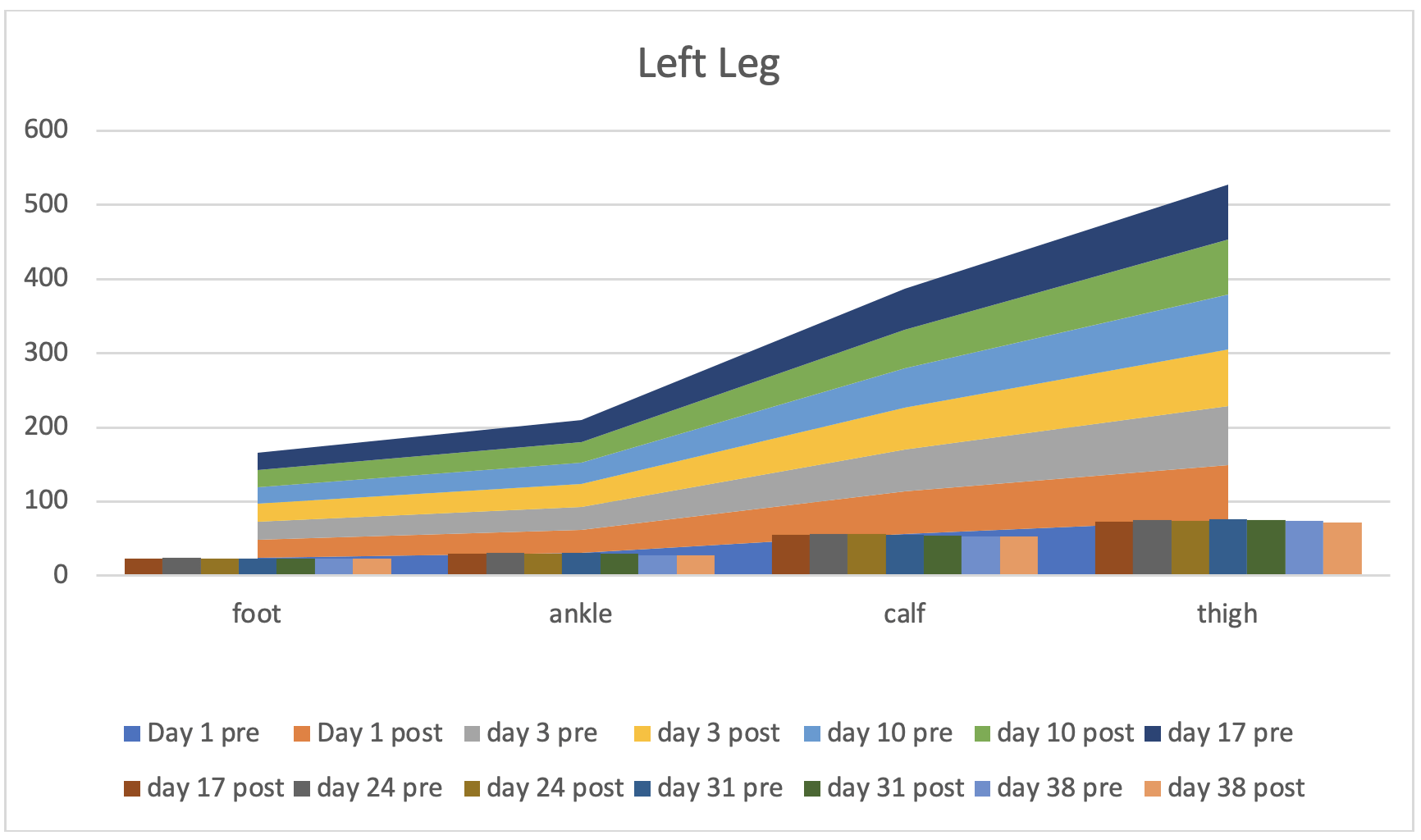
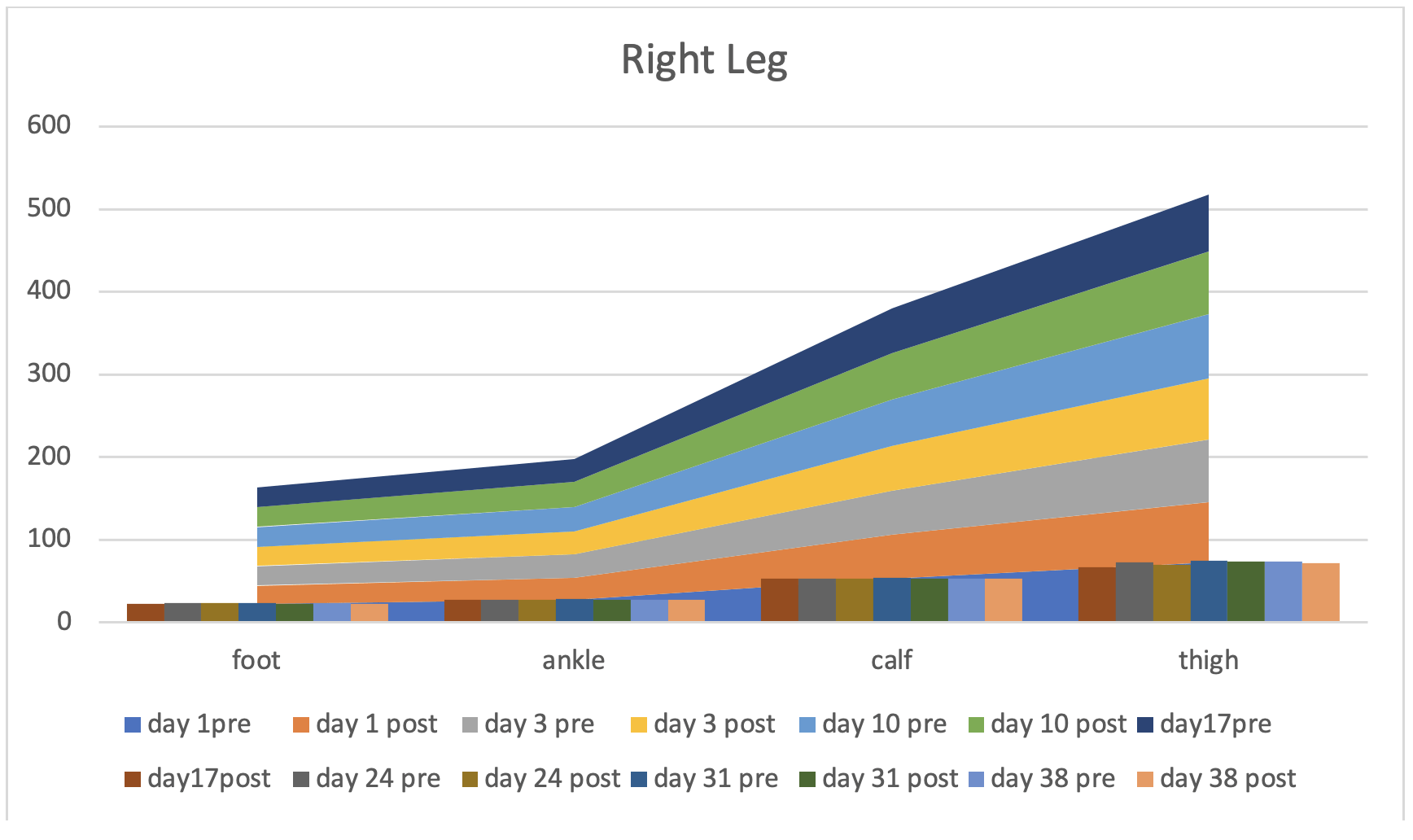
At her fifth appointment (day 24) the client told me she had started going for walks again. Initially 400 meters, and then 1 km. The 1 km walk did “cause and inflammatory response” (client’s words), and she felt a bit sore, but this eased off over the next two days, and she mentioned that she felt she now had a lot more energy.
The client also mentioned that she used to sweat heavily (smelly and thick) in the groin area, but this had resolved since the first treatment.
During the case study, the client was more optimistic about her condition and motivated to try more physical activities. She continues to manage her condition with regular MLD and BMT treatments and was encouraged enough by the results to now commit to wearing compression garments.
Discussion
This case study offers a great example of how MLD with BMT can assist with improving and managing the limitations imposed on the musculoskeletal system as well as the psychological limitations of lipedema and lymphedema.
Client feedback was routinely collected in regards to pain levels and quality of life, at each treatment. Measurements were taken pre and post each treatment, and photos were taken pre and post each treatment.
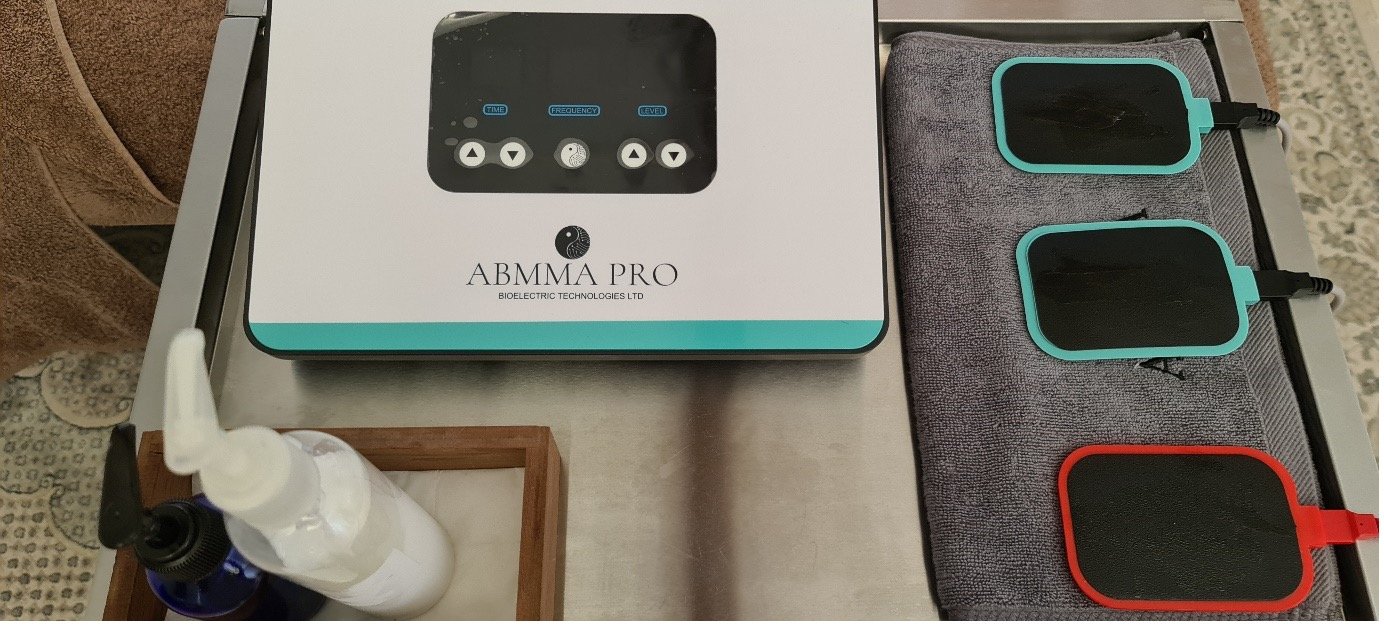
The client commented that she experienced less pain during and after each treatment. Her mobility was also greatly increased. MLD has been shown to reduce pain (3) and inflammation.
Light touch pain receptors are activated by gentle skin movements and stop sending pain signals to the brain (Gate Theory (4)).
The tissue pressure created by gentle MLD and muscle contraction via BMT, promote an increase in lymph movement.
Non-invasive modalities such as MLD and BMT can be effective in reducing limb volume as well as pain and inflammation associated with lipedema and lymphedema. These methods offer an alternative to more invasive treatments but it is important to work with a qualified healthcare professional who can provide an individual treatment plan to achieve the best outcomes.
Find out more about Bioelectric Meridian Therapy.
What I learned
Overall good results were achieved during this case study. Due to the client’s mobility, there were some time challenges due to the duration of the appointment times. More time would have been beneficial to allow the client to get undressed and dressed. . This would have allowed more time for treatment. Measurements also took up a lot of time The variations in time spent measuring each leg made it difficult to manage the time but this is a true reflection of a real life case.
I also learnt that although we always took measurements of the same areas, it would have been more accurate to take measurements perhaps every 2 to 5 cm. Both the client and I noticed differences in circumference just above where we took measurements for the ankle, and also around the knee area. This wasn’t always reflected in the areas we measured.
Disclaimer: Client consent was obtained for the use of content and photos.
References
- (https://www.lymphoedema.org.au/about-lymphoedema/what-is-lymphoedema/#What%20is%20lo)
- https://www.lipedema.org/
- Keser I, Esmer M. Does Manual Lymphatic Drainage Have Any Effect on Pain Threshold and Tolerance of Different Body Parts? Lymphat Res Biol. 2019 Dec;17(6):651-654. doi: 10.1089/lrb.2019.0005. Epub 2019 Jul 19. PMID: 31329499.
- https://abmma.com.au/bioelectric-therapy
- Kang DH, Jeon JK, Lee JH. Effects of low-frequency electrical stimulation on cumulative fatigue and muscle tone of the erector spinae. J Phys Ther Sci. 2015 Jan;27(1):105-8. doi: 10.1589/jpts.27.105. Epub 2015 Jan 9. PMID: 25642049; PMCID: PMC4305535.
- Kim SJ. Effects of manual lymph drainage on the activity of sympathetic nervous system, anxiety, pain, and pressure pain threshold in subjects with psychological stress. The Journal of Korean Physical Therapy. 2014;26(6):391-7.
- Williams A. Manual lymphatic drainage: exploring the history and evidence base. Br J Community Nurs. 2010 Apr;15(4):S18-24. doi: 10.12968/bjcn.2010.15.Sup5.78111. PMID: 20559172.


